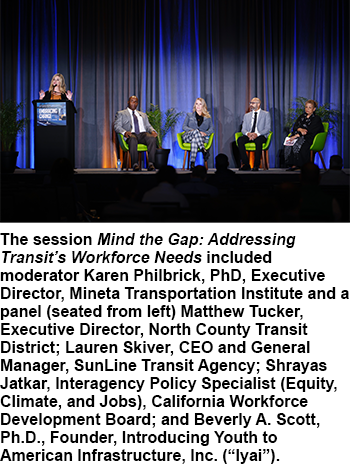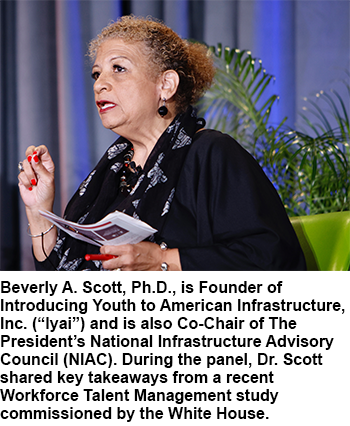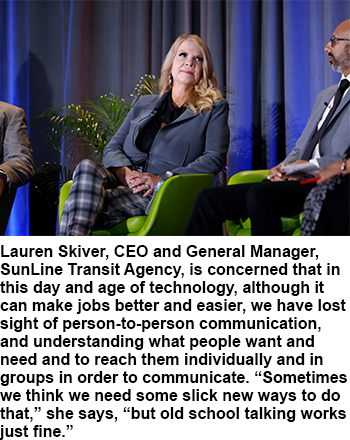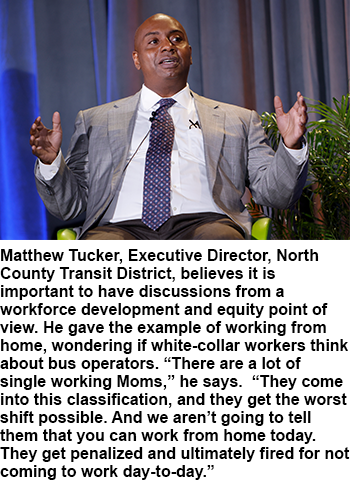 Workforce Development Challenges and Opportunities
Workforce Development Challenges and Opportunities
By Stephanie Jordan
Managing Editor
Transit California
One of the goals of the California Transit Association’s 56th Annual Fall Conference & Expo, was to bring together knowledgeable peers to broaden the dialogue around public transit, share new ideas, and learn what solutions are being implemented to address today’s challenges. One of the most difficult challenges for public transit agencies of all sizes is the severe bus operator shortage happening across the state and nation.
Public transit agencies are not alone.
Competition from Warehousing
In a recent report, What's Driving the Truck Driver Shortage in 2021?, Coyote Logistics teamed up with Emsi, a leading labor market research firm, to look at the problem through combining labor market data with on-the-ground expertise from logistics leaders. One of the key findings reveals: Some of the biggest competition for trucking companies is in the logistics industry, specifically warehousing. This is especially true for younger talent: 57 percent of drivers are over 45 years old, while 62 percent of warehouse employees are under 45. Another key finding: None of these sectors have the same barrier to entry that trucking does: a commercial driver’s license (CDL).
To explore public transit workforce shortage in greater detail, moderator Karen Philbrick, PhD, Executive Director, Mineta Transportation Institute and a panel including Shrayas Jatkar, Interagency Policy Specialist (Equity, Climate, and Jobs), California Workforce Development Board; Beverly A. Scott, Ph.D., Founder, Introducing Youth to American Infrastructure, Inc. (“Iyai+”); Lauren Skiver, CEO and General Manager, SunLine Transit Agency; and Matthew Tucker, Executive Director, North County Transit District came together for the plenary session Mind the Gap: Addressing Transit’s Workforce Needs.
“The biggest challenge that we face in workforce readiness, is that we say, very glibly, that people are our greatest resource, but we have not elevated people readiness,” said Scott. “We have not brought the same level of intentionality, the same rigor, and the same level of seriousness to the people readiness side of our business. That is really the heart of the matter.”
Scott, who is Co-Chair of The President’s National Infrastructure Advisory Council (NIAC), shared with conference participants recent results from the White House Commission Workforce Talent Management study (Pre-Decisional Copy, September 2021).
“This is the first time the White House, through the NIAC, has taken a specific look at people readiness within the infrastructure sectors (Transport, Communication, Water, and Energy), explained Soctt. “What we found was a disconnect in our country between traditional education and workforce job readiness. Between K-12 and higher education and when the private sector will step in at a point and time with real deep career preparation. We have made the four-year degree the default, it is the epitome of American success, and in the process de-valued and dis-assembled career technical education. That is our finding. In particular, as it relates to the infrastructure sectors, 75 to 80 percent of the positions do not require a college degree. And that is the big void that we have.”
What is the solution then? It is better workforce development.
"As a CEO, a lot of times we are managing the political influence and putting our agency first in line for funding or grant opportunities,” acknowledged Skiver. “SunLine has been focused on zero emission and on training for a long time, but even as good as we are, we lost sight about seven years ago in investing in our technicians and making sure they were up-to-date on the latest and greatest technology that was being developed. I think it was a wake-up call for me as a CEO to start understanding what we were doing to invest in our technicians.” 
Tucker weighs in, noting that workers that are on professional career paths that will receive training as part of their credentialing process. “Where I am putting my stake in the ground within the workforce development discussion,” he says, “is if you go through and look at your workforce within a transit agency, we know that labor is 68 to 80 percent of the agency cost. Then you go looking within that pie’s slices and see your largest classification is operators, whether they are bus operators or train operators. If you look at the big picture during this COVID period, a lot of us were not being very mindful of what was happening in terms of people leaving the workforce and the reason that people were leaving the workforce. But now, as we are starting to move to a different phase of COVID-19, we are looking around and who’s missing? It’s bus operators! The question is, how the heck did we get here? From a workforce development point of view, there are a bunch of different things that for me, I have been reflecting upon, engaging in discussions and readily admitting to some degree we are all hypocrites in what we say we believe and what we actually do. If you think about it during this whole pre-COVID, COVID and post-COVID period, there has always been this imbalance in terms of how we prepare our bus operators to come into this position, the training, the compensation, and the working conditions.”
Skiver added, “At SunLine we were still doing the old model of sending someone out of the unit to go become trained and expecting that person to come back and create this cycle of learning. And it just doesn’t work anymore. In the old-school way of managing transit, we did come to the table with a ‘them vs. us’ when it came to the benefits of learning. And it really has been to our detriment to continue that sort of approach to the way we work with our labor and our workforce. If people are not equipped they aren’t producing like they could be. A lot of times we look at productivity as being something that someone chooses not to engage in, but people that don’t have the tools to be productive can’t be productive. We have to look at the equation that way. It actually builds a much closer relationship with your employees. What I am here to say is this: We have to be brave enough to understand that we aren’t as good as we think we are at reaching our employees. At SunLine we talked it, but didn’t walk it in how we were engaging employees to train them. So, we had to be honest with them and everyone else about what needed to change in our organization. And we are changing it, and we are going to make that available to the whole transit industry.”
Investing in People
“I think there is a lot of talent out there,” continues Skiver. “We talk about how we don’t have enough talent, but we don’t even see the talent that we have in our own organizations right now. So, you can’t ask for more, when you won’t recognize and pull forward your own talent that you have right there in front of you. We need to be more equitable in the way that we make education accessible. You won’t believe the talent pool that you have. Look at what you have and find champions.
Skiver believes that for every investment made in technology, there needs to be one made in learning.
“The California Workforce Development Board is one of seven departments in the state’s labor and workforce development agency,” explained Jatkar as he was introduced. “Many folks may not know us. We have been investing in the transit sector under our high road training partner initiative for a number of years now. My main message is investing in the workforce is an investment in the industry. What we need to start doing -- across the board, this is not specific to the public transit industry – we need to start seeing labor as an asset worth investing in, not a cost to minimize. What we have seen in investment from training partnerships – like workers, employers, community groups – is the return on investment is good for the industry, as well as individual workers.”
Tucker agrees.
“When you look at this from a workforce development perspective, we really have to do a better job of making this a professional career. And a professional career involves a lot of different things. A professional career values me from a compensation point of view. When I say compensation, it is an exchange for productivity. They go hand-in-hand together. I am always struck – I love In-N-Out burger. If you see the wages they are paying, they are more or comparable to what most transit agencies are hiring new bus operators at. Or look at working conditions – take the split shift, which is the time between two pieces of work. It could be up to four hours and sometimes more, that you are unpaid. So, I think from a workforce development point of view, we have to address these seminal issues. We also have to be prepared to invest in training people who may not be ready to engage with the public from a customer service perspective. They may not have the skill set to communicate effectively with passengers. I am hoping that as we continue to have these discussions that we really drill down to the frontline perspective need.
Making Normal Happen
As part of the NIAC report, surveys helped to gather data. Scott tells of how she was told about how young people think of the transport sector, of which public transit is included. The good news, she was told, is that young people do not feel badly about the industry at all, but then came the other half of it: young people don’t think about this industry.
“We don’t tell our story enough,” asserted Scott. “We are not attractive to young people. I have been blessed to be in the business of community building for 40-plus years. It is what we do that makes it possible for people to have opportunity and possibilities. For that person that can go from point A to point B, and to see a community thrive and prosper. That is who we are. Why should kids be interested in our industry? Because we make normal happen.”
But Scott was quick to point out, that it isn’t just about young people, “If we want to grow the next group and give them visibility, there is mentoring, coaching, sponsoring and championing. But it can’t be just about the young people. It has got to be with real intentionality for people that are in our organizations now and the many that are stuck in the middle.”
Agreeing with Scott, Tucker said, “Boots on the ground. I think this is all about us, at the level that we are operating. We are going to have to create the change that we desire, because we are going to be the ones most impacted. Don’t look around, or look up. Look at yourself and make it happen at the local level.”